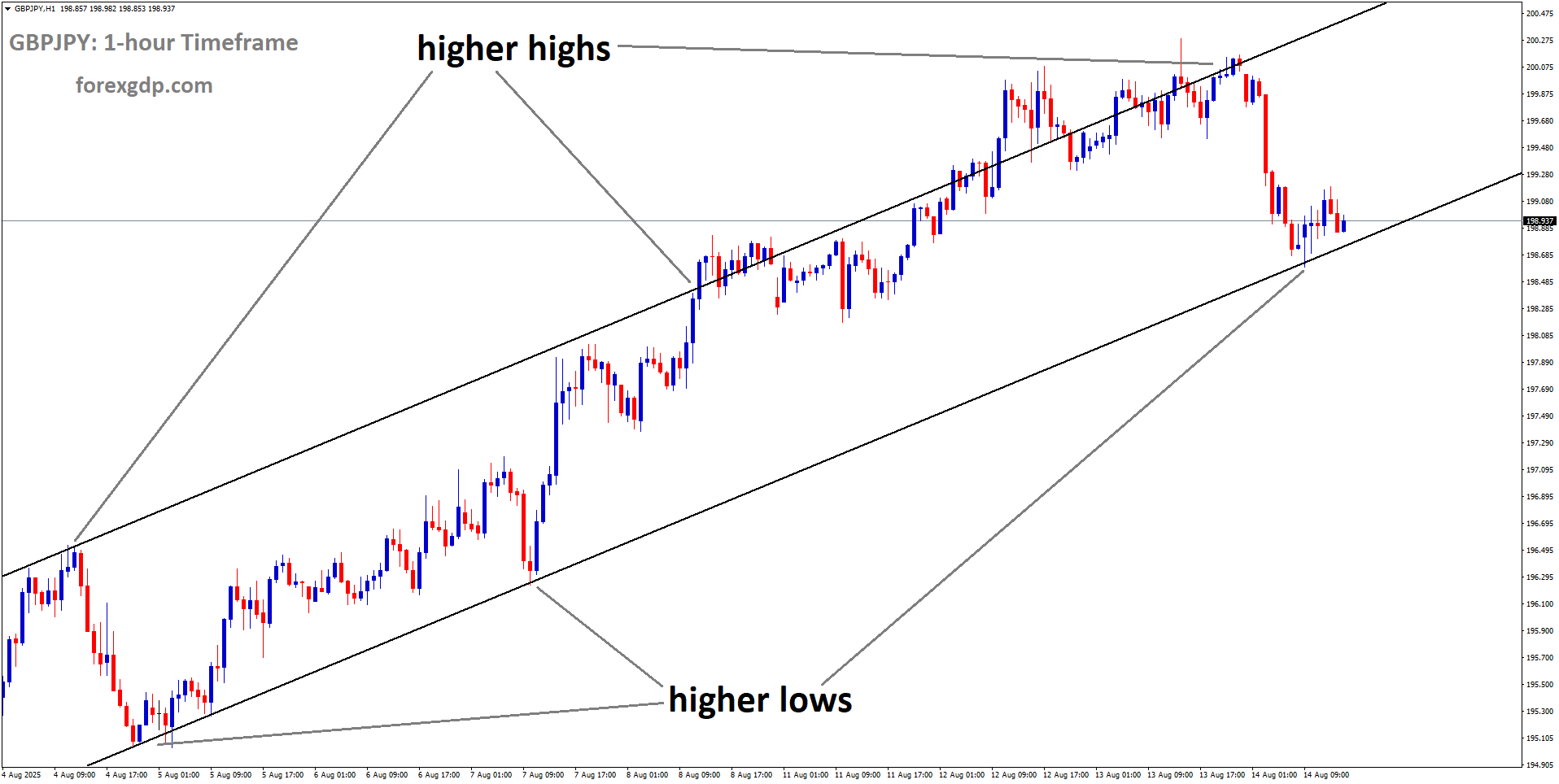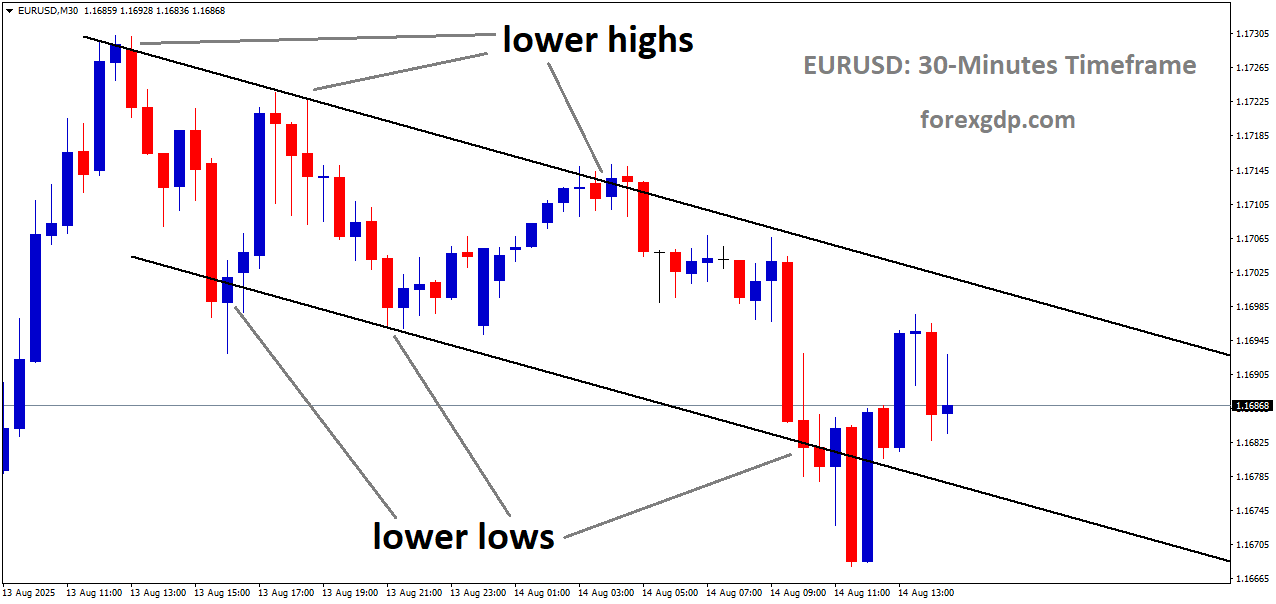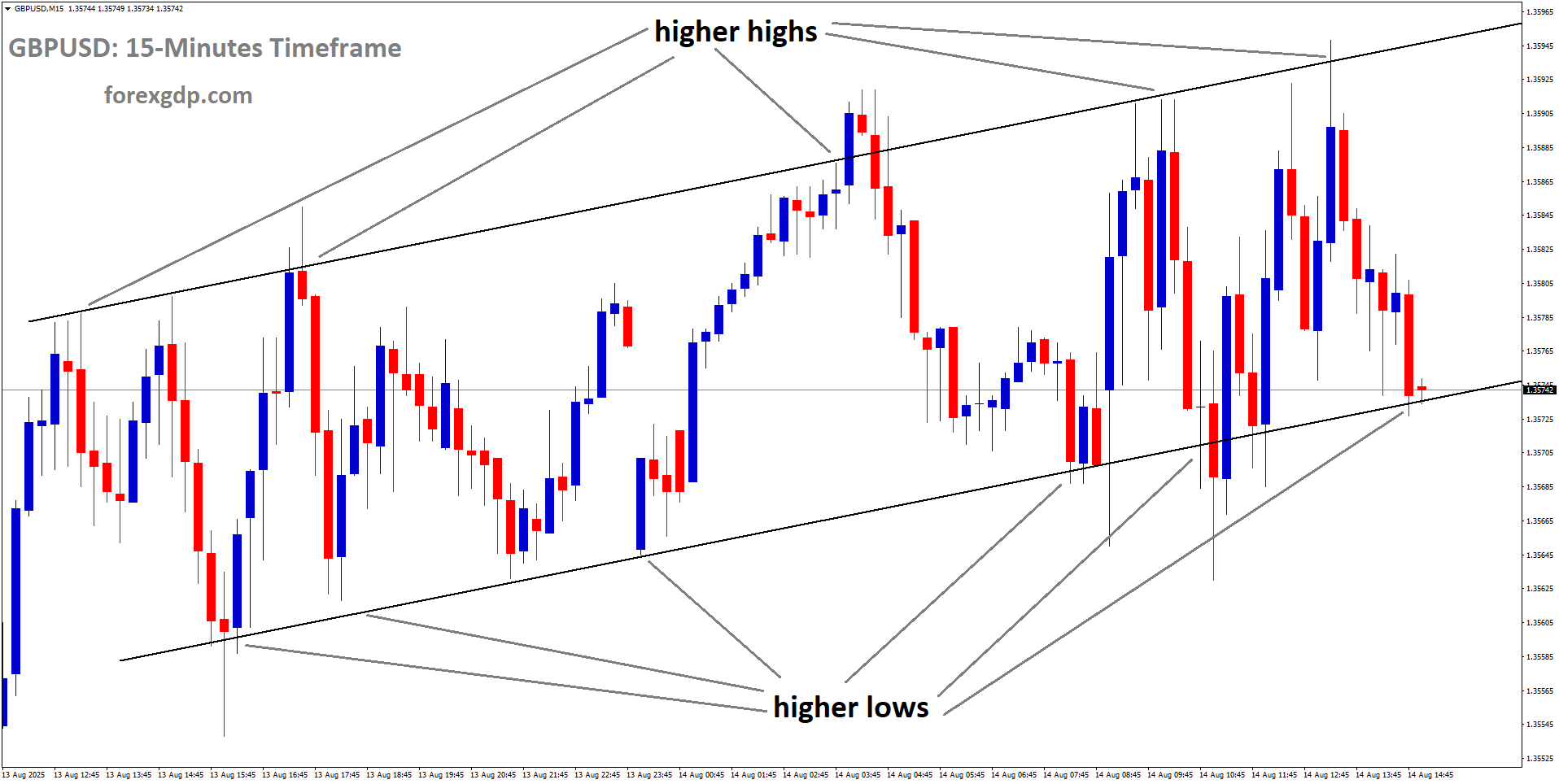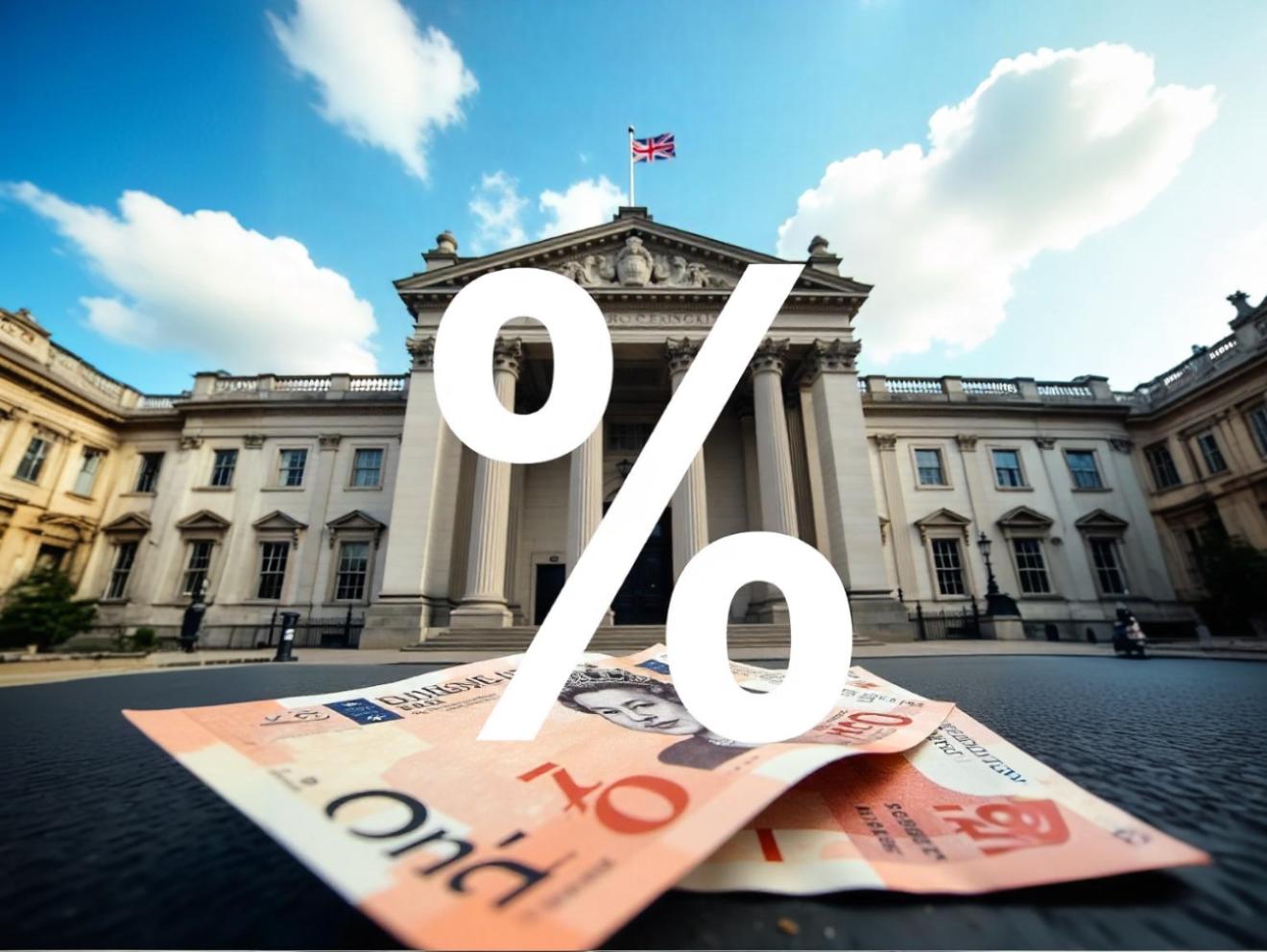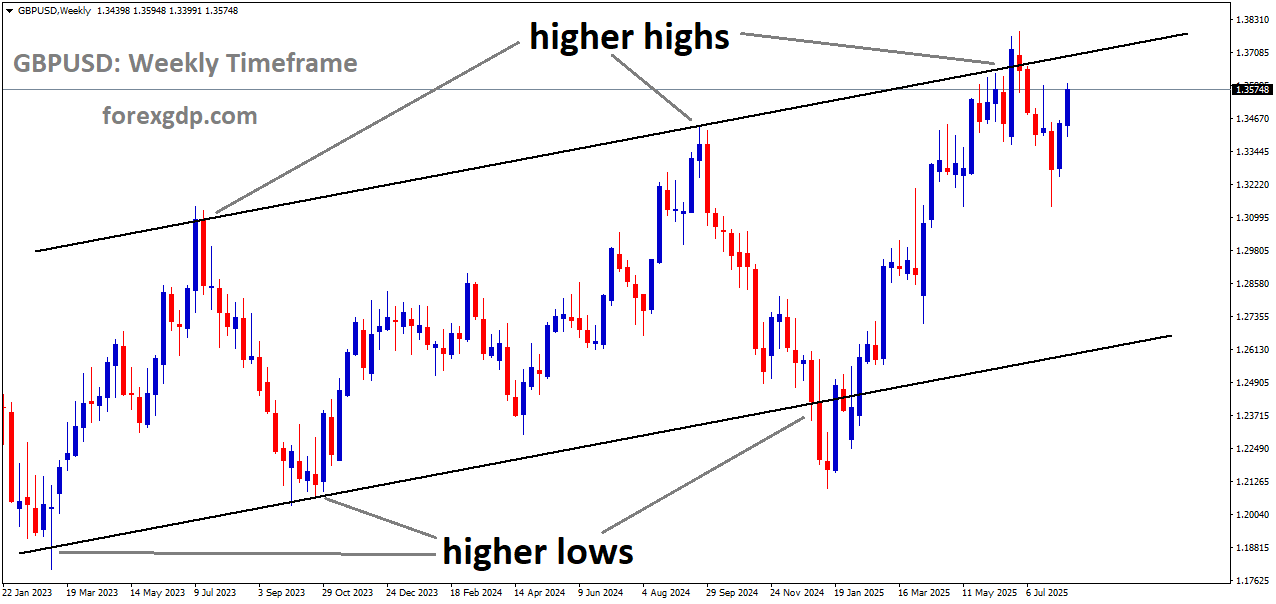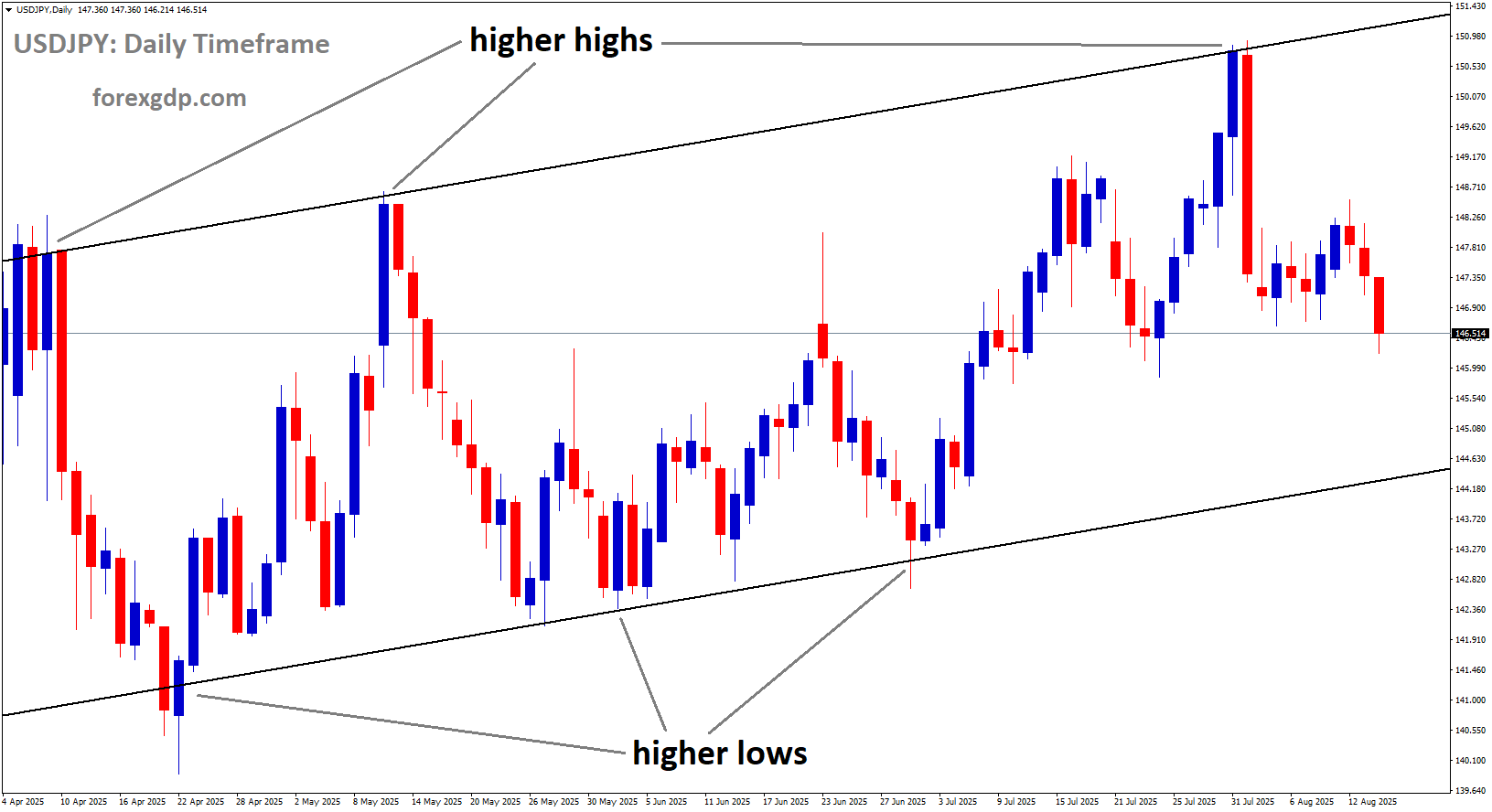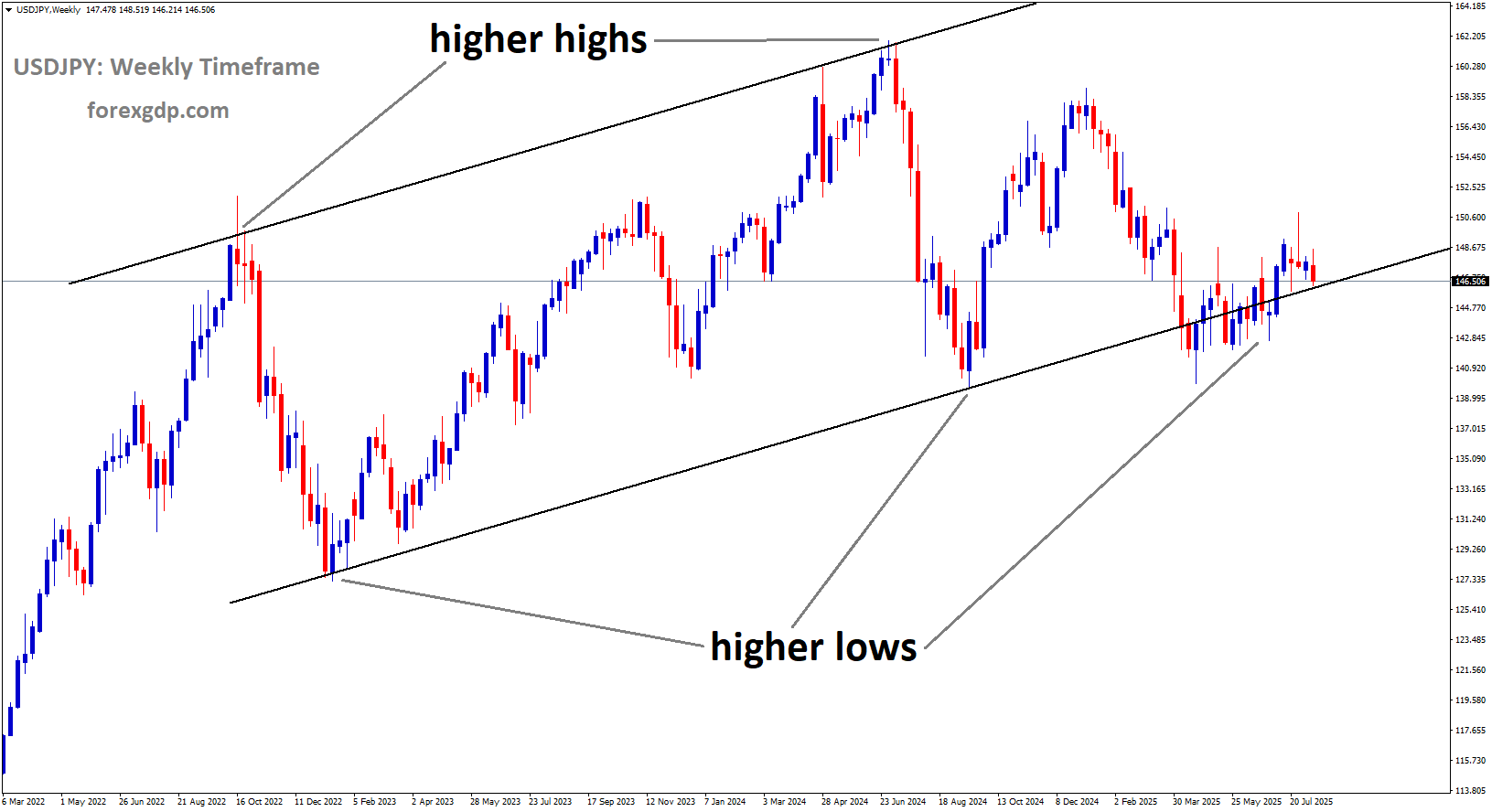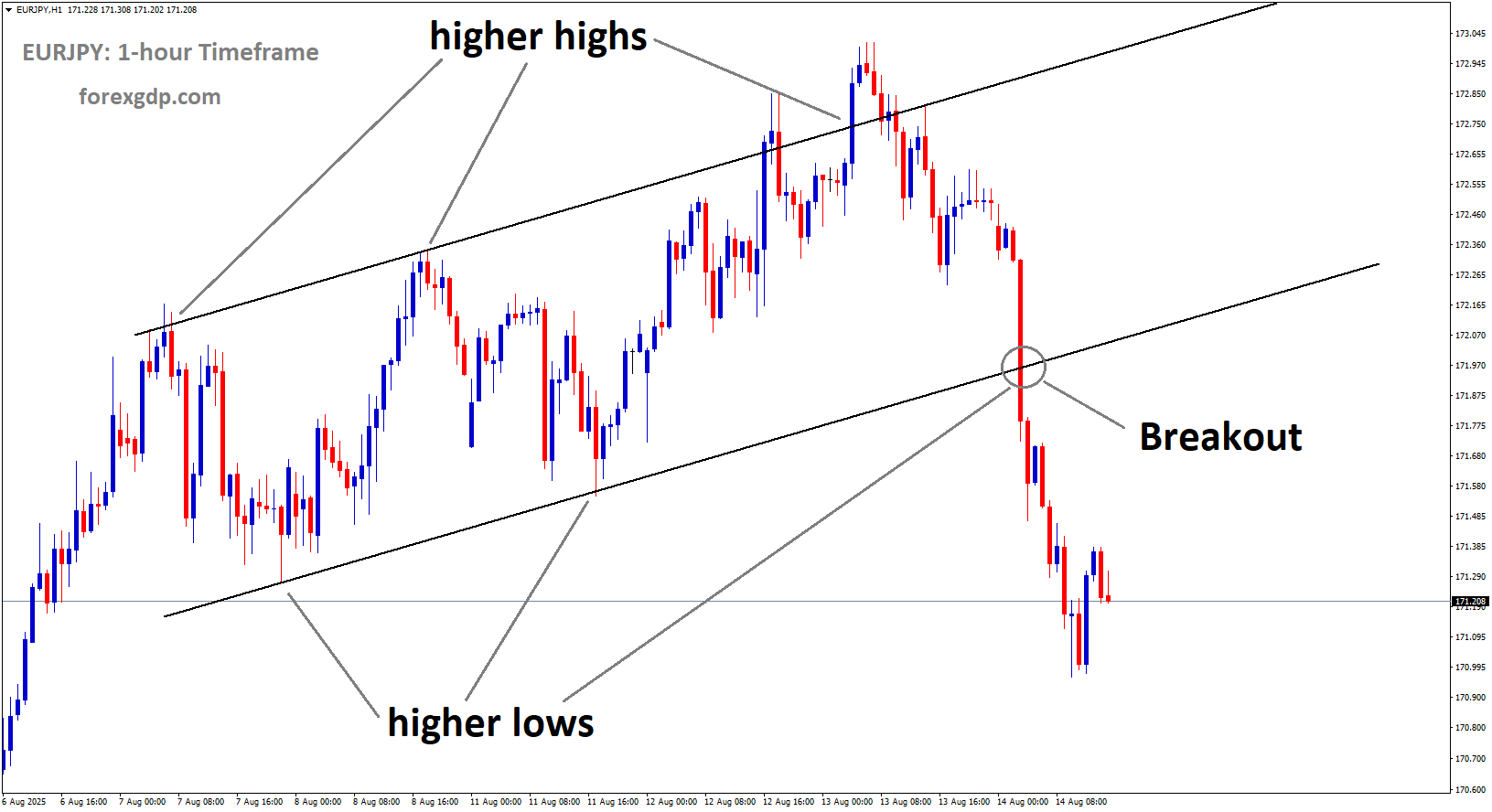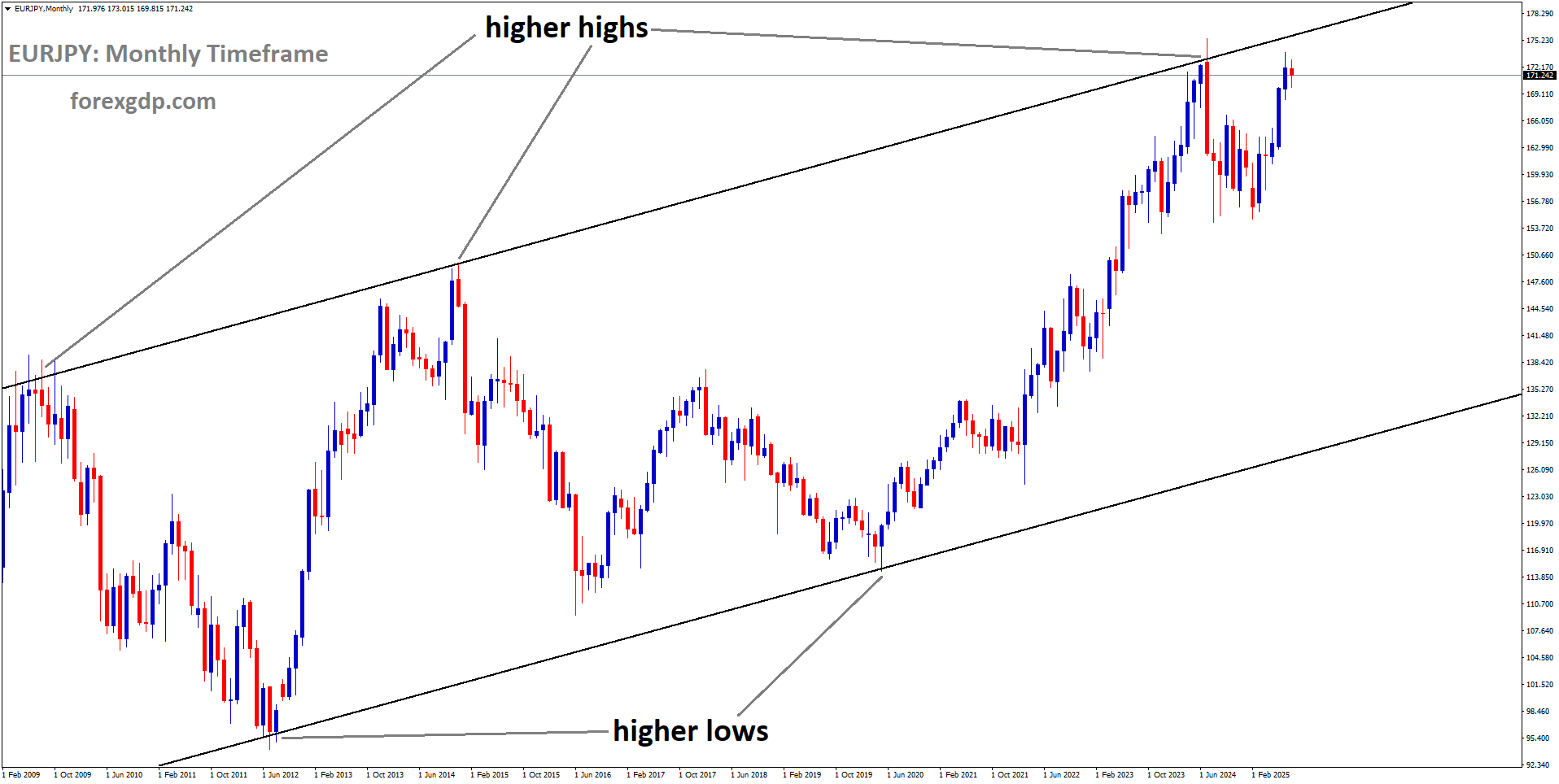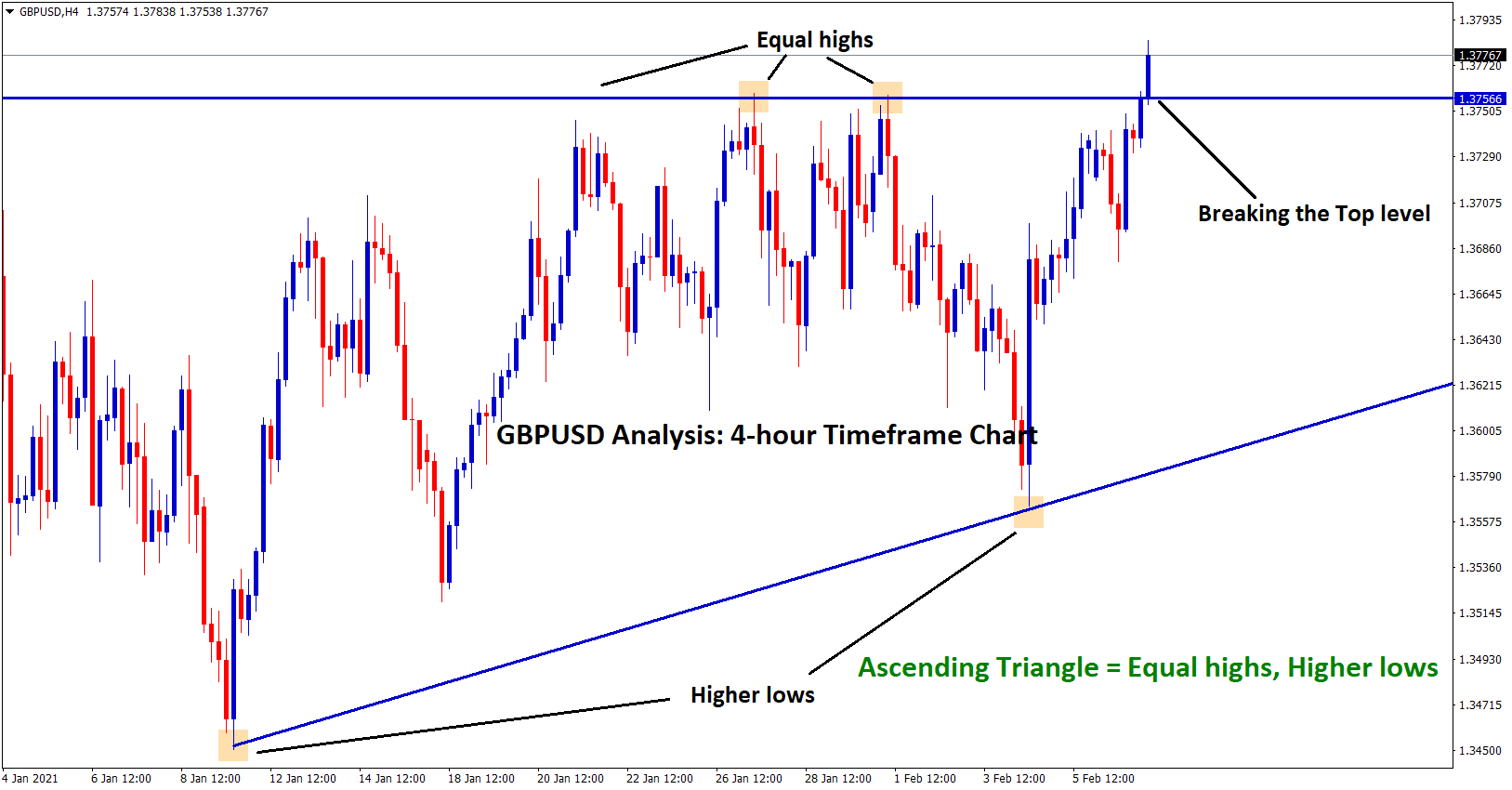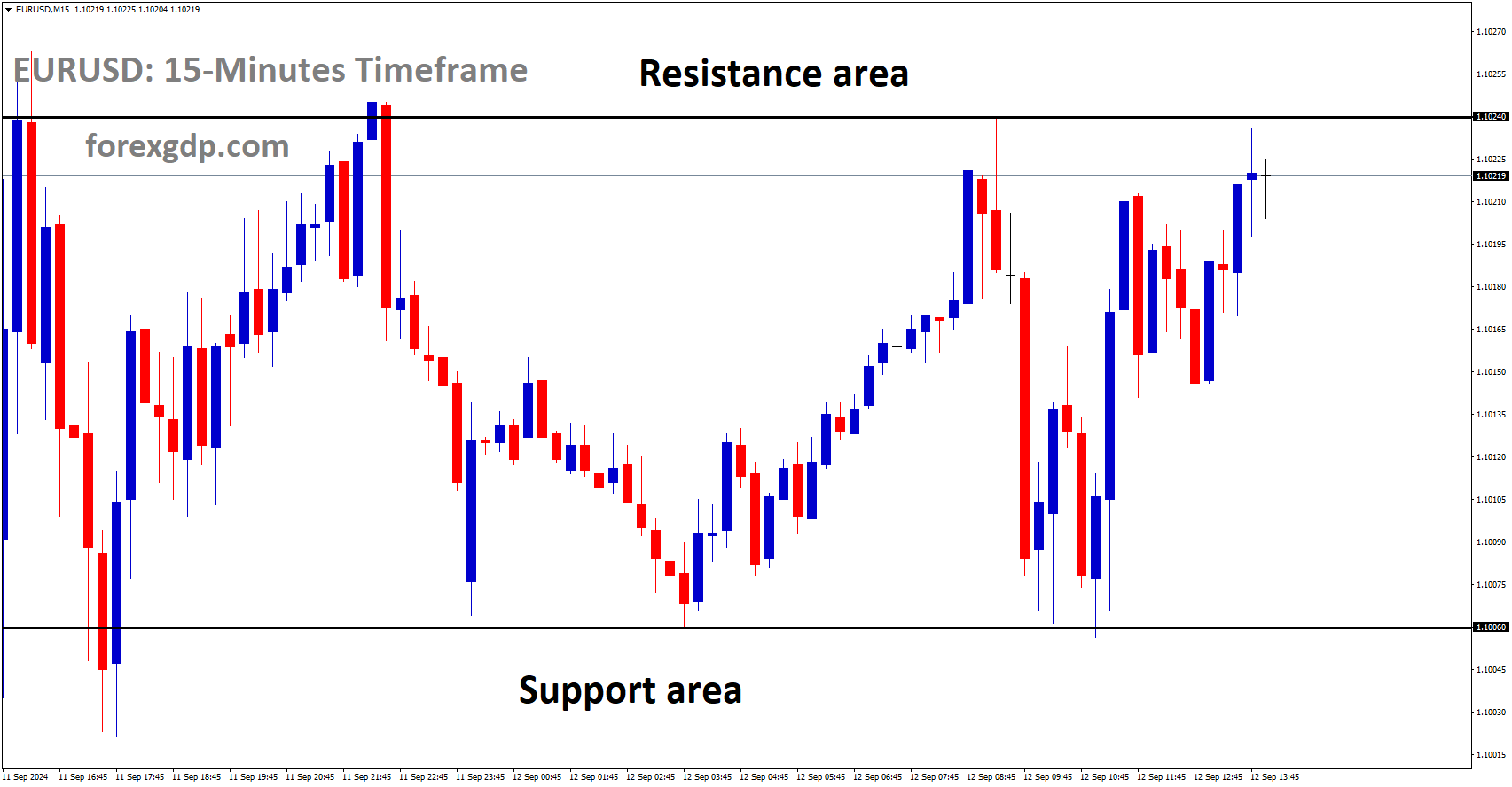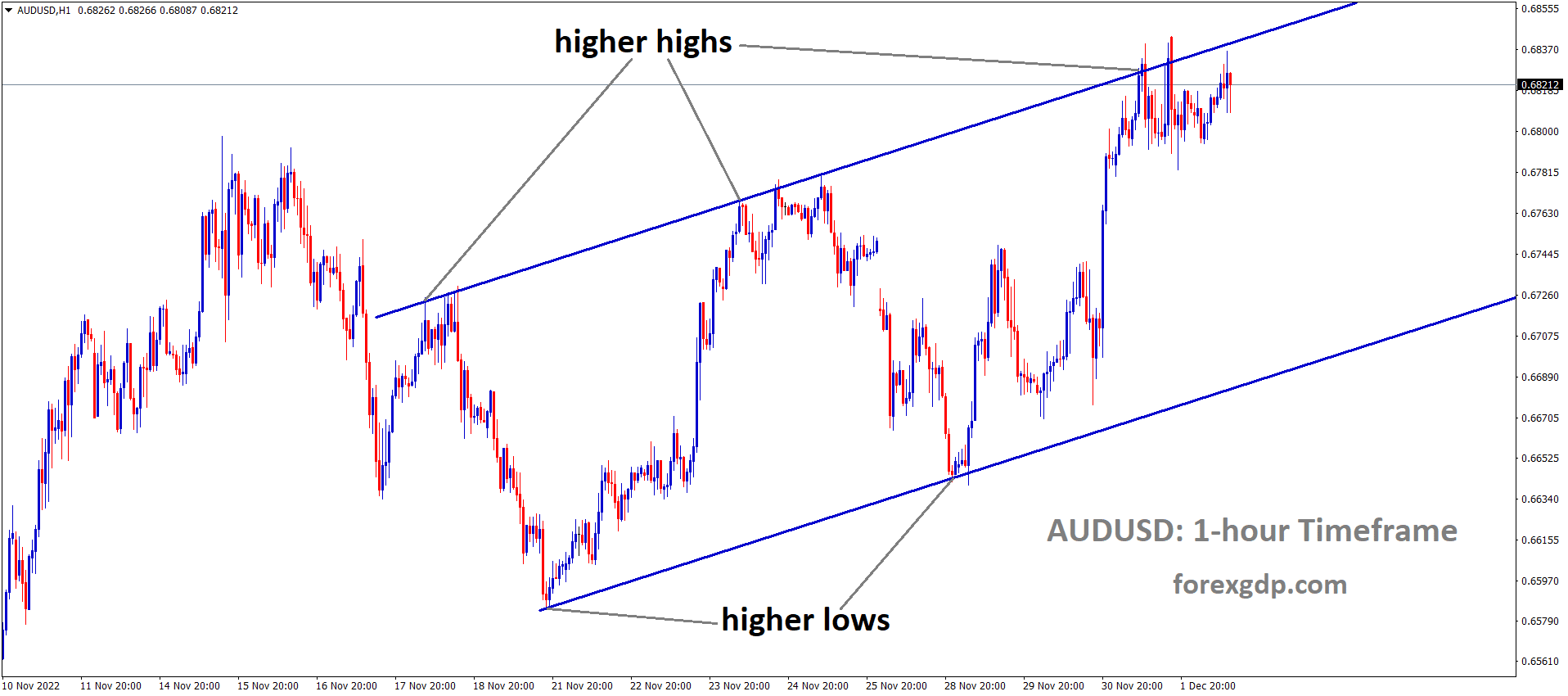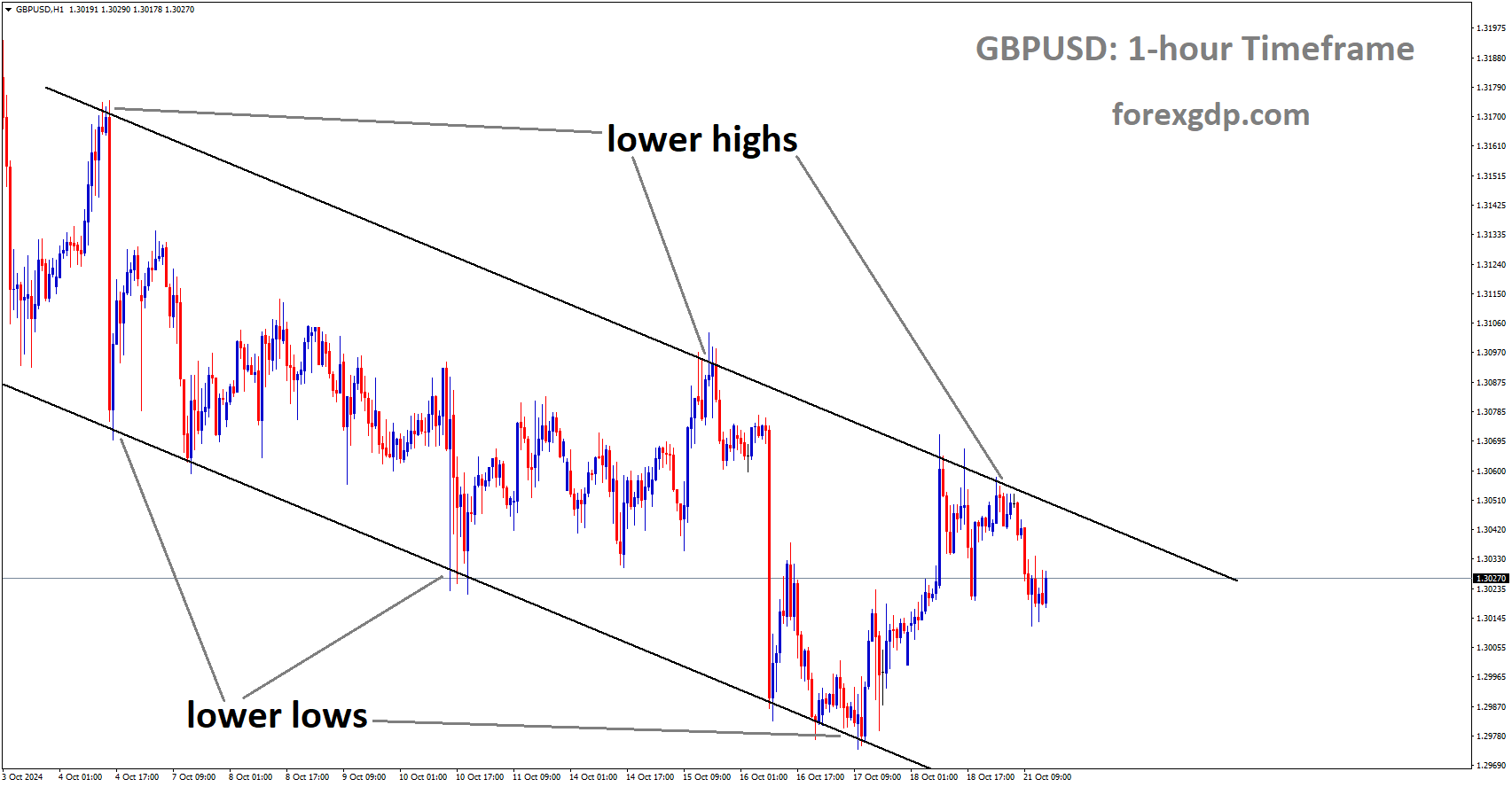GBPJPY is moving in an Ascending channel, and the market has reached the higher low area of the channel
Daily Forex Trade Setups Aug 14, 2025
Stay on top of market trends with our Daily Forex Trade Setups (Aug 14, 2025)
GBPJPY Lifts Higher as Strong UK GDP Sparks Fresh Optimism
The GBP/JPY currency pair has recently drawn attention as it found support after a sharp pullback. This renewed buying interest came in the wake of stronger-than-expected UK economic data, which has given traders more reasons to hold onto their bullish outlook for the British Pound. With positive GDP and manufacturing numbers out of the UK, alongside notable developments in Japan’s monetary policy expectations, the market has been buzzing with activity.
UK Economic Growth Outpaces Expectations
The latest figures from the Office for National Statistics (ONS) show that the UK economy performed better than many analysts had anticipated.
Q2 GDP Surprises to the Upside
In the second quarter of the year, the UK economy grew by 0.3%, which was a significant beat compared to forecasts of just 0.1%. This came after a stronger 0.7% growth in the previous quarter, showing resilience in the face of global economic uncertainties.
June Sees a Strong Rebound
After a small contraction of 0.1% in May, June saw a solid bounce back with 0.4% growth—well above the expected 0.1%. This improvement was supported by better industrial and manufacturing production figures, which also exceeded projections.
These upbeat numbers have reinforced the belief that the UK economy is still showing momentum, even with the ongoing challenges of inflation, global trade tensions, and shifting interest rate expectations.
Why This Data Matters for GBP/JPY Traders
Economic data is a major driver for currency movements, and these UK figures carry weight for several reasons.
Impact on Bank of England’s Policy Path
The stronger growth figures suggest that the UK economy is not slowing down as much as some feared. This could mean that the Bank of England (BoE) will maintain its cautious approach to monetary policy. While the BoE recently cut its benchmark rate by 25 basis points, the decision was a close call, and the central bank signaled it would proceed with “gradual and careful” adjustments.
With the latest data showing resilience, the odds of further immediate rate cuts are lower. For currency traders, this translates into sustained demand for the Pound, as higher interest rates—or even expectations of them—can attract capital inflows.
Japanese Yen Outlook Shaped by BoJ Expectations
While the UK data supports the Pound, the Japanese Yen has been experiencing its own set of influences.
Signals of Higher Rates in Japan
Comments from US Treasury Secretary Scott Bessent have added fuel to expectations that the Bank of Japan (BoJ) may be preparing for further interest rate hikes. Speaking to Bloomberg TV, Bessent noted that the BoJ was “behind the curve” and would need to act more aggressively to control inflation.
For years, Japan has maintained ultra-low interest rates to stimulate growth, but rising inflationary pressures are prompting a shift in strategy. If the BoJ raises rates, it could provide some strength to the Yen. However, the pace and scale of such moves remain uncertain, which leaves room for volatility in pairs like GBP/JPY.
Market Sentiment and Short-Term Outlook
The GBP/JPY pair has been trading actively, with recent sessions showing both sharp declines and quick recoveries. The bounce following the UK’s GDP release suggests that traders are willing to buy dips when economic fundamentals support the move.
In the short term, much will depend on upcoming economic reports, central bank commentary, and geopolitical developments. Any fresh signs of economic strength in the UK—or hints of policy tightening in Japan—could spark bigger moves.
Key Takeaways for Traders and Investors
-
UK GDP Beats Expectations – Strong Q2 and June growth data reinforce confidence in the British economy.
-
BoE Policy Uncertainty – While the central bank recently cut rates, robust data may delay further reductions.
-
BoJ Under Pressure – Rising inflation in Japan could lead to rate hikes, influencing Yen performance.
-
GBP/JPY Volatility Likely to Continue – With both sides of the pair influenced by central bank decisions, traders should be ready for swift price swings.
GBPJPY is moving in a box pattern, and the market has reached the resistance area of the pattern
Final Summary
The recent strength in UK economic data has breathed new life into the British Pound, especially against the Japanese Yen. With GDP and manufacturing output both outperforming forecasts, traders are leaning toward a more optimistic view of the UK’s economic outlook. At the same time, speculation over potential interest rate hikes in Japan adds another layer of complexity to the GBP/JPY dynamic.
For now, the pair’s direction will likely hinge on the balance between UK economic resilience and Japan’s evolving monetary stance. Traders should watch for further data releases and central bank commentary, as these could set the tone for the next big move in GBP/JPY.
EURUSD Retreats Modestly as Traders Watch for Fed Insights
The Euro is on a winning streak, climbing steadily against the US Dollar as traders react to fresh inflation numbers from the United States. The latest US Consumer Price Index (CPI) report has fuelled market optimism that the Federal Reserve might cut interest rates as early as September. With this shift in sentiment, risk appetite is growing, and the USD is feeling the pressure.
Let’s break down what’s driving this move and why the Euro is benefiting.
EURUSD is moving in an Ascending channel, and the market has rebounded from the higher low area of the channel
US Inflation Data Sparks Talk of Rate Cuts
The big driver behind the Euro’s rise is the moderate inflation reading in the US. July’s CPI figures showed that consumer prices remained stable, which caught the market’s attention. Instead of picking up pace as many expected, inflation didn’t rise sharply — giving the Fed more breathing room to consider rate cuts.
This news comes against a backdrop of a slowing labour market, making the case for easier monetary policy even stronger. A rate cut could help boost economic growth and employment, but it also makes the US Dollar less attractive compared to other currencies, including the Euro.
Why a Softer CPI Matters
A lower-than-expected CPI figure signals that inflation isn’t running out of control. For the Fed, that means less pressure to keep interest rates high. And for traders, it opens the door to betting on looser monetary policy — something that usually weakens a currency.
Political Moves Add to Market Uncertainty
It’s not just inflation that’s shaping the currency markets. There’s also political chatter in the US that could influence the Fed’s direction. Reports suggest that President Trump might try to fill open central bank seats with officials who favour looser policy.
If that happens, it could lead to a more dovish Fed, potentially cutting rates faster or deeper than expected. But there’s a catch — such moves could also raise concerns about the Fed’s independence, which is traditionally seen as crucial for maintaining global trust in the US financial system.
This political angle has added another layer of downward pressure on the US Dollar, further fuelling the Euro’s climb.
Markets Are Hungry for Risk
With rate cuts on the table, investors have been more willing to shift into riskier assets. This appetite for risk tends to hurt safe-haven currencies like the USD while benefiting other majors such as the Euro.
At the moment, there are no major economic data releases in the immediate pipeline, so the market is leaning heavily on central bank commentary for direction. All eyes are on speeches from Fed officials, as traders look for hints about whether the September rate cut is really locked in.
Fed’s Mixed Messages
Interestingly, the Fed itself isn’t entirely united on the issue. Recent comments show a clear split:
-
Some policymakers, like Thomas Barkin, have been downplaying inflation concerns, suggesting more room for easing.
-
Others, like Jeffrey Schmid, still argue for keeping rates higher for longer to make sure inflation is firmly under control.
Despite this divide, the market is heavily leaning towards a cut. Data from the CME Group’s FedWatch Tool shows the probability of a September rate cut has jumped to 95% from 85% before the CPI release. Traders are also pricing in the likelihood of at least one more cut later in the year — possibly in October or December.
Europe’s Role in the Story
While the Euro’s move is largely a result of US developments, Europe’s own economic updates have played a smaller role. Germany’s latest inflation figures, measured by the Harmonized Index of Consumer Prices (HICP), confirmed a modest price rise both monthly and yearly.
These numbers didn’t make a huge impact on the Euro, but they do show that inflation in the Eurozone’s largest economy is well below the levels seen in the US, which could give the European Central Bank more room to maintain its own policy stance without rushing into aggressive tightening.
What Traders Are Watching Next
For now, the focus is squarely on the Fed. Traders want confirmation that the central bank is ready to pull the trigger on rate cuts. Any strong hint from Fed officials will likely keep the USD under pressure and could give the Euro another leg higher.
Risk sentiment is also a key factor. As long as investors feel confident about the global economy — and as long as rate cuts remain on the horizon — the demand for the US Dollar is likely to stay muted.
EURUSD is moving in a descending channel
Final Summary
The Euro’s recent strength isn’t happening in isolation — it’s a direct reaction to the shifting US economic landscape. Softer inflation, a cooling labour market, and growing expectations of a Federal Reserve rate cut in September have created the perfect environment for the USD to weaken.
Political uncertainty over Fed appointments has added extra downward pressure, while a global appetite for riskier assets has made the Euro an attractive alternative. Europe’s own data has played a smaller role, but stable inflation in Germany provides some support for the currency.
In short, the balance of risks now leans against the US Dollar. Unless upcoming Fed commentary unexpectedly changes the narrative, the Euro’s upward momentum could continue in the weeks ahead.
GBPUSD Surges as Strong UK GDP Figures Spark Investor Optimism
The Pound Sterling has been making waves in the currency market, gaining solid ground against major global currencies. This boost came after fresh data revealed that the United Kingdom’s economy grew faster than expected in June and showed a stronger overall performance in the second quarter of the year. Alongside GDP growth, the UK’s factory sector made a remarkable return to expansion after facing a significant contraction just a month earlier.
The upbeat numbers have renewed investor confidence in the Pound, with many traders now rethinking how the Bank of England (BoE) might approach its next interest rate moves. Let’s break down what’s driving this surge in the British currency and why it matters for both the UK economy and global markets.
GBPUSD is moving in an Ascending channel, and the market has reached the higher low area of the channel
UK GDP Growth Surpasses Expectations
Economic growth is often the heartbeat of a currency’s strength, and for the UK, the latest figures have given the Pound Sterling a strong push. The Office for National Statistics (ONS) announced that GDP in the second quarter rose by 0.3%, far above the market expectation of 0.1%.
To put it in perspective, the first quarter of the year saw a robust 0.7% growth, so while the pace has slowed slightly, it’s still a clear sign that the economy is holding up better than feared.
June’s performance was especially encouraging. After a disappointing May, when the economy contracted by 0.1%, June saw a sharp rebound of 0.4% growth. Analysts had expected only a modest 0.1% rise, so this outcome was a pleasant surprise for both economists and investors.
Factory Sector Stages a Comeback
Another bright spot in the UK’s economic report was the revival of its factory sector. The manufacturing and industrial production figures for June showed strong month-on-month growth:
-
Manufacturing output rose by 0.5%
-
Industrial production increased by 0.7%
This turnaround came after significant declines in May, suggesting that certain parts of the economy are proving resilient despite ongoing global challenges.
The improvement in the factory sector signals stronger domestic production capacity, which is often a sign of better business confidence. When factories are producing more, it often means there is either stronger local demand, increased export orders, or both.
Impact on Bank of England Policy
With stronger-than-expected GDP and factory output, the Bank of England may now have more room to maneuver without rushing into aggressive interest rate cuts.
Earlier this month, the BoE cut its benchmark interest rate by 25 basis points, bringing it down to 4.00%, while maintaining its guidance for a “gradual and careful” approach to monetary policy. However, it was a close call — four out of nine policymakers actually voted to keep rates unchanged.
The new economic data could strengthen the case for holding rates steady in the near term, as it shows the economy is not as fragile as some feared. Keeping rates higher for longer could help control inflation, which remains an important priority for the central bank.
US Developments Also Influence the Pound
While UK data has been a big driver for Sterling’s gains, events across the Atlantic have also played a role. The US Dollar has been under pressure lately as traders grow more confident that the Federal Reserve will cut interest rates in its September policy meeting.
Market tools that track rate expectations now show that investors have almost fully priced in a 25 basis points rate cut. This expectation stems from:
-
Signs of a cooling US labor market
-
Inflation data that shows no strong upward pressure from recent tariffs
-
Slower job creation in recent Nonfarm Payroll reports
-
Downward revisions to earlier employment data
Adding to the pressure on the Dollar, US Treasury Secretary Scott Bessent recently voiced support for a more aggressive monetary easing path. He even suggested the possibility of a 50-basis-points rate cut in September, arguing that rates are currently “too constrictive” and should be lowered significantly to support the economy.
When the US Dollar weakens due to such expectations, the Pound Sterling tends to benefit, making the latest UK data even more impactful.
Why This Matters for the Pound Sterling’s Outlook
A stronger economy often means stronger currency demand — and right now, the UK appears to be in a better position than many had predicted a few months ago. The combination of higher-than-expected growth, improving industrial performance, and favorable interest rate dynamics compared to the US is giving Sterling a solid foundation.
If the Bank of England holds its rates steady while the Federal Reserve cuts aggressively, the yield advantage for holding GBP over USD could grow, attracting more investors to the Pound.
However, it’s worth noting that currency markets are sensitive to changing data. Future economic releases, both in the UK and abroad, will shape whether this momentum for Sterling can continue.
GBPUSD is moving in an uptrend channel
Final Summary
The recent surge in the Pound Sterling is no accident — it’s being powered by a rare combination of positive domestic economic news and favorable international conditions.
The UK’s GDP growth in both June and the second quarter beat forecasts, while the factory sector rebounded sharply after a tough May. This resilience may give the Bank of England reason to hold back on deeper interest rate cuts, supporting the Pound further.
At the same time, the US Dollar is losing ground as markets anticipate a Fed rate cut, potentially even a large one, in September. With both domestic and external factors aligning in Sterling’s favor, the currency is enjoying a strong period that could extend if upcoming data continues to support this positive narrative.
USDJPY Slips with Yen Rally on Rising BoJ Rate Hike Expectations
The Japanese Yen (JPY) has been gaining strength for three straight days, and Thursday marked another win for the currency against the US Dollar (USD). What’s driving this momentum? It’s not just about economic numbers or technical charts—it’s about market expectations, central bank policies, and a mix of global economic factors that keep investors on their toes.
USDJPY is moving in an Ascending channel, and the market has fallen from the higher high area of the channel
Why the Yen Is Outshining the Dollar
The Japanese Yen’s rally isn’t coming out of nowhere. Investors have been paying close attention to the Bank of Japan (BoJ), and recent signals suggest the central bank might be getting ready for a more aggressive approach toward interest rates.
Back in July, the BoJ raised its inflation forecast and hinted at the possibility of a rate hike before the year ends. This shift is significant because Japan has historically kept rates extremely low, and any change in this stance attracts a lot of attention.
Meanwhile, across the Pacific, the US Federal Reserve (Fed) seems to be moving in the opposite direction. Markets widely believe the Fed will cut rates in September, especially after a series of disappointing US economic reports. When one central bank talks about raising rates while another leans toward cutting them, it creates a big gap in investor expectations—one that tends to favor the currency linked to the more hawkish bank.
The BoJ’s Hawkish Turn and Its Impact
Central Bank Policy Divergence
The BoJ’s willingness to raise interest rates has been the main driver of the Yen’s strength. For years, Japan has been known for its ultra-loose monetary policy, but with inflation picking up and economic conditions shifting, the central bank seems ready to take a different route.
Higher interest rates often make a currency more attractive because they can lead to better returns for investors. This means global funds that seek safer, more rewarding assets could shift toward the Yen.
The Fed’s Softer Stance
On the other side, the Fed is facing growing pressure to cut rates. Economic signals—like a weaker labor market and softer consumer data—are fueling expectations that the central bank will ease policy to support growth. Recently released US Nonfarm Payroll numbers and consumer inflation data suggest the economy may not be as strong as previously thought, giving the Fed more reason to act.
This contrast between Japan’s potential tightening and America’s likely loosening is one of the biggest reasons the Yen is seeing sustained demand.
Safe-Haven Appeal Still Matters
Even though stock markets have been upbeat and risk appetite is relatively strong, the Japanese Yen is still benefiting from its reputation as a safe-haven currency. Normally, in a “risk-on” environment—when investors are more willing to take chances—currencies like the Yen lose some shine. But this time, the underlying story is different.
The BoJ’s policy shift is providing fundamental support for the Yen, making it attractive even when global markets are rallying. Investors aren’t just looking at the short-term sentiment—they’re factoring in the possibility of a new era for Japanese interest rates.
Challenges That Could Slow the Yen’s Climb
While the overall bias seems to favor the Yen, there are still factors that could slow or even temporarily reverse its gains.
Domestic Economic Concerns
Japan’s own economic data has been a mixed bag. Real wages have been falling for months, and corporate price growth is slowing down. Both trends raise concerns about whether Japan’s economy can handle tighter monetary policy without hurting growth.
If consumer spending remains weak or if corporate profits start to feel the pressure, the BoJ might think twice before moving forward with additional hikes.
Political and Trade Risks
Domestic political uncertainty and tensions related to global trade—especially with the US—could also play a role. Higher US tariffs on Japanese goods could weigh on the economy, making it harder for the BoJ to maintain a hawkish stance.
Global Factors Supporting the Yen
It’s not just Japan’s policy changes pushing the Yen higher—global events are also lending a hand.
-
US-China Trade Truce Extension: A temporary pause in tariff escalation between the two largest economies is boosting investor confidence, but it’s also shifting expectations for currency moves.
-
US-Russia Talks: Optimism around potential diplomatic progress is adding to market calm, yet hasn’t dampened the Yen’s appeal.
-
Stock Market Records: Japan’s Nikkei 225 hitting record highs and US indices like the S&P 500 and Nasdaq also reaching fresh peaks reflect a strong risk environment—yet the Yen remains in demand thanks to central bank divergence.
What’s Next for USD/JPY?
The short-term moves in the USD/JPY pair will likely hinge on upcoming US economic data and commentary from Federal Reserve officials. Thursday’s US Producer Price Index release could influence USD demand, while Friday brings Japan’s Q2 GDP figures and the US Consumer Sentiment Index.
If US data continues to disappoint and BoJ signals remain firm, the Yen could extend its winning streak. However, any signs that the BoJ might hold off on further hikes—or if US data unexpectedly improves—could spark some pullback.
USDJPY is moving in an uptrend channel, and the market has reached the higher low area of the channel
Final Summary
The Japanese Yen’s recent rally is being powered by a unique combination of factors: a hawkish shift from the Bank of Japan, a softer outlook for US interest rates, and the currency’s ongoing safe-haven appeal. Even in a generally risk-positive environment, the Yen is standing out, thanks largely to policy divergence between the BoJ and the Fed.
Still, Japan’s domestic challenges—like falling real wages and potential trade headwinds—mean the path forward won’t be without bumps. Investors will be watching closely for new economic data and central bank comments to see if the Yen’s momentum can continue.
In short, the Yen’s strength isn’t just about current sentiment—it’s about a possible long-term shift in Japan’s monetary landscape, and that has traders paying very close attention.
EURJPY Slides as US Treasury Chief Slams BoJ, Markets Await Eurozone Growth Data
The currency market saw notable movement when the EUR/JPY exchange rate fell sharply, driven by political remarks and shifting expectations for Japan’s monetary policy. While currency pairs fluctuate daily, this drop came with an extra layer of global attention — and it’s worth digging into what really happened and why it matters for traders and investors alike.
A Heated Critique from the US Treasury
The story began when US Treasury Secretary Scott Bessent openly criticized the Bank of Japan (BoJ) over its handling of inflation. He didn’t mince words, saying Japan’s central bank is “behind the curve” and needs to raise interest rates to rein in rising prices.
EURJPY has broken the Ascending channel on the downside
This wasn’t just casual commentary — Bessent also made it clear he would bring up the matter directly with BoJ Governor Kazuo Ueda. Such direct criticism from a major economic figure like the US Treasury Secretary is rare and tends to make markets react immediately.
Japan’s Cautious Inflation Strategy
For years, the BoJ has walked a fine line with its inflation policy. Instead of focusing heavily on headline inflation — which is the overall rise in prices — it has given more weight to domestic demand and wage-linked inflation data.
Governor Kazuo Ueda has been defending this careful approach, pointing out that “underlying inflation” in Japan is still below the central bank’s 2% target. In other words, the BoJ sees room to wait before making aggressive policy moves.
However, not everyone on the board agrees. Some members believe that with headline inflation sitting at 3.3% in June, the central bank should take stronger action. This internal debate adds another layer of uncertainty for global traders.
Why the Euro Matters in This Story
Interestingly, even as the Japanese Yen gained strength from these developments, the Euro wasn’t entirely on the defensive. In fact, there’s been ongoing market sentiment that the European Central Bank (ECB) may have already wrapped up its long streak of interest rate cuts.
The ECB made eight rate cuts over the past year, bringing borrowing costs down to the lowest they’ve been since late 2022. While the door isn’t completely shut on another cut before the year ends, traders largely believe the aggressive easing cycle has ended.
That perception gives the Euro a certain degree of support, especially when compared to currencies tied to central banks that are still in the middle of big policy shifts.
Looking Ahead: Key Economic Data on the Horizon
While political and central bank commentary can spark short-term moves, the next big wave of influence may come from economic data releases.
This week, traders are waiting for the Eurozone Industrial Production numbers and second-quarter GDP data. Both reports could provide important clues about the overall health of the Eurozone economy — and by extension, the Euro itself.
Stronger-than-expected results could give the Euro more resilience against a stronger Yen. On the other hand, disappointing figures could deepen the recent EUR/JPY weakness.
Potential Scenarios Traders Are Watching
-
If Japan signals a shift toward higher interest rates sooner than expected, the Yen could extend its gains, putting further pressure on EUR/JPY.
-
If the Eurozone data comes in strong, it could help the Euro push back against Yen strength, possibly stabilizing or even reversing recent losses.
-
If both Japan tightens policy and Eurozone data disappoints, EUR/JPY could see an even deeper slide.
Why This Moment Feels Different
Currency traders are used to central banks moving slowly and cautiously. But what makes this situation stand out is the public pressure from a foreign government figure. When a US Treasury Secretary openly urges another country’s central bank to change policy, it adds diplomatic tension into an already complex economic equation.
EURJPY is moving in an Ascending channel, and the market has reached a higher high area of the channel
For Japan, the challenge is balancing domestic economic stability with the reality of a globally connected financial market. For Europe, it’s about proving that its economy can grow even after interest rate cuts have stopped.
Final Summary
The recent drop in EUR/JPY was triggered by more than just regular market noise — it’s a mix of political pressure, shifting central bank strategies, and anticipation of upcoming economic data.
Japan is under growing international pressure to tighten monetary policy, with the US Treasury Secretary calling out the BoJ for moving too slowly on inflation. Meanwhile, the Euro’s fate hangs on both the ECB’s recent policy stance and upcoming Eurozone data.
For traders, this is a period where headlines and data releases could cause quick and sharp movements in the market. Staying informed and ready for volatility is key, as the tug-of-war between the Yen and Euro continues in the weeks ahead.

